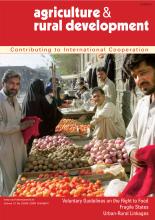/ library resources
Showing items 1 through 9 of 18.This paper contains a preliminary summary of key issues and findings from a desk review of
the literature on land titling projects and programmes in urban and peri-urban areas of
developing countries. It draws on a large number of documents, not all of which have been
Not only rabbits and guinea-pigs but sheep, goats, cattle and pigs also play a crucial role in the food and income situation of countless city-dwellers world-wide. However, when people and animals live in such close proximity, health risks are inevitable.
Rural development and urbanisation are often seen as competing, but in most cases are intimately linked. It is essential that policies re? ect and support the many positive links between rural and urban areas, enterprises and people.
The early development strategies of both China and India were urban- and industry-focused, discounting the importance of rural development. Despite sweeping reforms in both countries, the urban bias and subsequent spatial disparities still exist today.
Dar es Salaam is one of the fastest growing cities in sub-Saharan Africa. In its rapidly expanding peri-urban fringe poor migrants from distant rural areas settle down on plots they can afford that provide access to urban markets.
Despite ambitious desertification control programmes, the area of desertified land has expanded continuously since the establishment of the People's Republic of China, with increasingly serious impacts on important industrial and settlement areas.
Two images have dominated the northern media in recent months.The first is of desolation in remote, rural areas in Africa affected by drought, conflict or famine, such as in Somalia, northern Kenya or Darfur, Sudan.
Urbanisation and economic transformation - the growth of non-farm, industrial and service sectors - offer many opportunities for improvements in poor people's lives.The crucial challenge is to ensure that places work better for people, providing an enabling and supporting environment for changing
Although «urban» and «rural» development are often considered as in opposition to each other and seen as competing with each other for investment and support, many urban centres owe much of their economic base to agriculture.
Pagination
Land Library Search
Through our robust search engine, you can search for any item of the over 73,000 highly curated resources in the Land Library.
If you would like to find an overview of what is possible, feel free to peruse the Search Guide.






